 W
W21_21 Design Sight is a museum in Roppongi in Minato, Tokyo, Japan, which opened in 2007. The museum, a design museum, was created by architect Tadao Ando and fashion designer Issey Miyake. "The idea was to create not only a museum that shows exhibits," says Ando, "but also a place for researching the potentiality of design as an element that enriches our daily life, a place that fosters the public's interest in design by arousing in them different sights and perspectives on how we can view the world and the objects surrounding us." The building, designed by Ando, is on the edge of the park area, and features 1,700 square meters of floor space, including two galleries and an attached cafe run by chef and restaurateur Takamasa Uetake. The split-level concrete structure includes a hand-sanded steel roof and 14-meter (46 ft) long glass panels.
 W
WThe Textile Culture and Ukiyo-e Art Museum – Amuse Museum , or simply Amuse Museum, is a private museum specializing in Japanese textile culture and ukiyo-e. It opened on 1 November 2009 in Asakusa, Tokyo, not too far from Ueno Park, where multiple other museums are located.
 W
WThe Ancient Orient Museum is a small private museum in Tokyo, Japan, specializing in artifacts of the ancient Near East and Central Asia. It has a collection of Greco-Buddhist art of Gandhara, and several works of art pertaining to the art of Palmyra and Persia.
 W
WArtizon Museum Aatizon Bijutukan (アーティゾン美術館), until 2018 Bridgestone Museum of Art , is an art museum in Tokyo, Japan.
 W
WAsakura Museum of Sculpture or Asakura Choso Museum is a museum in Tokyo that showcases the sculptures and life work of Fumio Asakura (1883-1965). The art museum is located specifically in the Yanaka neighborhood of Taito, in Tokyo. The museum opened in 1967 after Asakura's death.
 W
WThe Bunkamura is a concert hall, theater and museum located in Shibuya, Tokyo, Japan, operated by Tokyu Group.
 W
WThe Eisei Bunko Museum is a museum in Bunkyo-ku district in Tokyo, Japan. Its collection includes historical documents and artifacts, and works of fine art. The museum is located what was formerly the grounds of the Hosokawa clan, near the Shin-Edogawa Garden.
 W
WGallery Itsutsuji is a contemporary art gallery founded in 1990 by Michiyasu Itsutsuji.
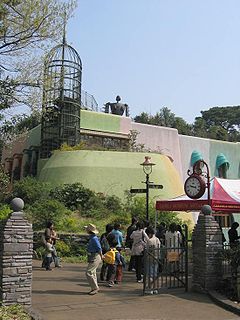 W
WThe Ghibli Museum is a museum showcasing the work of the Japanese animation studio Studio Ghibli. It is located in Inokashira Park in Mitaka, a western city of Tokyo, Japan. The museum combines features of a children's museum, technology museum, and a fine arts museum, and is dedicated to the art and technique of animation. Features include a replica of the Catbus from My Neighbor Totoro (1988), a café, bookstore, rooftop garden, and a theater for exclusive short films by Studio Ghibli.
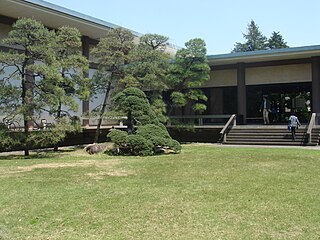 W
WThe Gotoh Museum is a private museum in the Kaminoge district of Setagaya on the southwest periphery of Tokyo. It was opened in 1960, displaying the private collection of Keita Gotō, chairman of the Tokyu Group. Today's collection is centered on the original selection of classical Japanese and Chinese art such as paintings, writings, crafts and archaeological objects completed by a small selection of Korean arts. It features several objects designated as National Treasures or Important Cultural Properties. The exhibition changes several times per year with special openings in spring and fall. A garden with a tea house, ponds and small Buddhist statues is attached to the museum.
 W
WThe Hara Museum of Contemporary Art was one of the oldest contemporary art museums in Japan. The museum was in the Kita-Shinagawa district, in the Shinagawa area of Tokyo.
 W
WThe Hasegawa Machiko Art Museum is an art museum in Setagaya, Tokyo, Japan.
 W
WThe Hatakeyama Memorial Museum of Fine Art is a private museum established in October 1964 in Tokyo, Japan.
 W
WThe Japan Folk Crafts Museum is a museum in Komaba, Meguro, Tokyo, Japan, dedicated to the hand-crafted art of ordinary people (mingei).
 W
WThe Kodaira Hirakushi Denchu Art Museum is an art museum in the city of Kodaira in western Tokyo, Japan, dedicated to the life and work of Japanese master wood sculptor Hirakushi Denchū (1872–1979). The museum preserves the last home and studio of Denchu, where he moved in 1970, and has a purpose-built exhibition annex building housing many of the sculptor's works.
 W
WKodansha Noma Memorial Museum is located in Bunkyo, Tokyo, Japan. Its collection includes fine Japanese art objects.
 W
WThis museum is now closed. Try the Uta Memorial Museum near Meijijingumae Station to see Ukiyo-e prints from Hiroshige, Hokusai and others.
 W
WThe Matsuoka Museum of Art is a private museum located in Shirokanedai, Minato, Tokyo, founded by Japanese developer Seijiro Matsuoka in November 1975.
 W
WThe Meguro Museum of Art, Tokyo is an art gallery in Meguro, Tokyo, Japan.
 W
WThe Mitsubishi Ichigokan Museum, Tokyo is an art museum in Tokyo's Marunouchi district.
 W
WThe Mitsui Memorial Museum is an art museum in Tokyo's Nihonbashi district. It is located within the Mitsui Main Building, an Important Cultural Property as designated by the Japanese government.
 W
WThe Mori Art Museum is a contemporary art museum founded by the real estate developer Minoru Mori (1934–2012) in the Roppongi Hills Mori Tower in the Roppongi Hills complex both of which he built in Tokyo, Japan.
 W
WThe Museum of Contemporary Art Tokyo is a contemporary art museum in Koto, Tokyo, Japan. The museum is located in Kiba Park. It was opened in 1995.
 W
WThe Museum of the Imperial Collections Sannomaru-Shōzōkan (三の丸尚蔵館) is located on the grounds of the East Garden of Tokyo Imperial Palace. It showcases a changing exhibition of a part of the imperial household treasures.
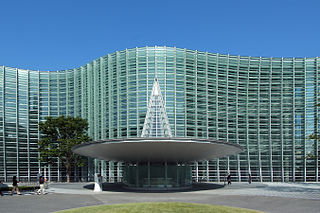 W
WThe National Art Center (NACT) is a museum in Roppongi, Minato, Tokyo, Japan. A joint project of the Agency for Cultural Affairs and the National Museums Independent Administrative Institution, it stands on a site formerly occupied by a research facility of the University of Tokyo.
 W
WThe Tokyo National Museum of Modern Art in Tokyo, Japan, is the foremost museum collecting and exhibiting modern Japanese art.
 W
WThe National Museum of Western Art is the premier public art gallery in Japan specializing in art from the Western tradition.
 W
WThe Nezu Museum , formerly known as the Nezu Institute of Fine Arts, is an art museum in the Minato district of Tokyo, Japan.
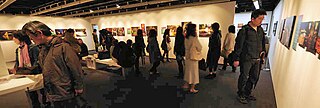 W
WNikon Salon is the name given to exhibition spaces and activities run by Nikon in Japan.
 W
WNTT InterCommunication Center (ICC) is a media art gallery in Tokyo Opera City Tower in Shinjuku, Tokyo, Japan. It was established by NTT to commemorate the 100th anniversary of telephone service in Japan and opened in 1997. In addition to permanent and temporary exhibitions featuring international and Japanese artists, ICC holds workshops, performances, symposia, and produces publications with the goal of advancing communication between artists and scientists.
 W
WOkura Museum of Art is a museum in Tokyo, Japan.
 W
WThe Ukiyo-e Ōta Memorial Museum of Art is a museum that opened in Shibuya, Tokyo, Japan, in January 1980. It presents rotating exhibitions of Ukiyo-e from Ōta Seizo V's collection of over 12,000 pieces.
 W
WSeikadō Bunko Art Museum (静嘉堂文庫) is a museum of East Asian art in Setagaya, Tokyo.
 W
WThe Setagaya Art Museum is an art museum in Yōga, Setagaya, Tokyo. The museum, which opened March 30, 1986, houses a permanent gallery and mounts seasonal exhibitions.
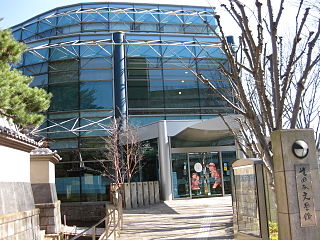 W
WThe Setagaya Literary Museum is an art museum in Minami-Karasuyama, Setagaya, Tokyo. It is owned by Setagaya City and operated by Setagaya Cultural Foundation. The museum was founded in April 1995 as a comprehensive museum of modern literature originated from Setagaya. It also functions as a library, as well as museum and archives.
 W
WThe Sompo Japan Head Office Building is the corporate headquarters for Sompo Japan Insurance. It is located in the district Nishi-Shinjuku in Shinjuku, Tokyo, Japan. At 200 metres (656 ft), the building is the 28th tallest building in Tokyo and the 33rd tallest in Japan. It was designed by Yoshikazu Uchida.
 W
WThe Suntory Museum of Art is an arts museum located in Tokyo Midtown, Roppongi, Tokyo. It is owned by the Suntory corporation. The collection theme of the art works is "Art in life" and they mainly have Japanese antiques.
 W
WTibet House is an international, loosely affiliated group of nonprofit, cultural preservation organizations founded at the request of the Dalai Lama, to preserve, present, and protect Tibet's ancient traditions of philosophy, mind science, art, and culture due to the Chinese invasion of Tibet in 1950 and subsequent Tibetan diaspora. The first Tibet House was founded in New Delhi, India in 1965.
 W
WTokyo Fuji Art Museum was established by Daisaku Ikeda and opened near the Sōka University campus in Hachiōji, Tokyo, Japan, in 1983. The new wing was added in 2008. The collection of some thirty thousand works spans the arts and cultures of Japan, Asia, and Europe, and the Museum takes touring exhibitions to other countries.
 W
WThe Tokyo Metropolitan Art Museum is an art museum in Tokyo, Japan. It is one of Japan's many museums which are supported by a prefectural government. The current structure, designed by Kunio Maekawa, was completed in 1975.
 W
WThe Tokyo Metropolitan Teien Art Museum is an art museum in Tokyo, Japan.
 W
WThe Tokyo Photographic Art Museum is an art museum concentrating on photography.
 W
WThe Watari Museum of Contemporary Art in Shibuya, Tokyo stands together with the Mori Arts Center and the 21st Century Museum of Contemporary Art, Kanazawa as one of the major institutions in Japan and in Asia in the field of contemporary visual arts. It was designed by the architect Mario Botta in 1990.
 W
WThe Yamatane Museum is a museum in Japan specializing in the nihonga style of Japanese watercolour painting. It is run by the Yamatane art foundation.
 W
WThe Yayoi Kusama Museum is a contemporary art museum in Tokyo, Japan dedicated to the work of the Japanese artist Yayoi Kusama. The Museum is located in the Shinjuku Ward, in the western suburbs of Tokyo, Japan.
 W
WYokoyama Taikan Memorial Hall is located in the former residence of Nihonga artist Yokoyama Taikan, overlooking Shinobazu Pond in Taitō, Tokyo, Japan. It was opened in 1976 and is operated by a foundation directed by his descendants.